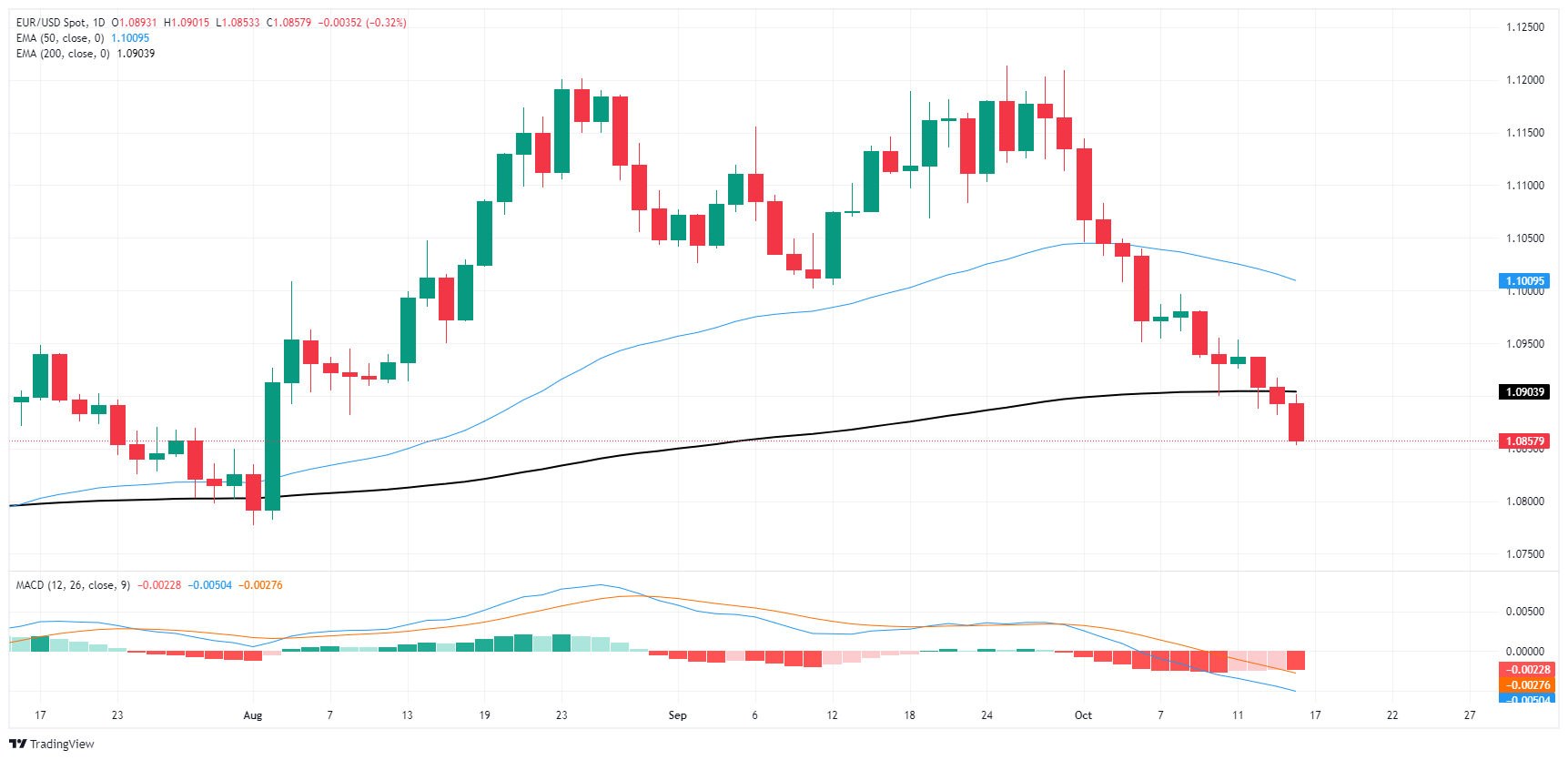EUR/USD backslides to a ten-week swing low ahead of ECB rate call


- EUR/USD withered further on Wednesday, sagging below 1.0900.
- ECB rate cut looms large around the corner, broadly expected to trim rates 25 bps.
- Final EU inflation figures are unlikely to move the needle on Thursday.
EUR/USD is in freefall, plummeting to multi-week lows as the Euro continues to crumple ahead of the European Central Bank’s (ECB) upcoming rate call on Thursday. The ECB is widely expected to trim interest rates by a quarter of a percent, or 25 bps.
All eyes will be on the ECB during Thursday’s European market session. The ECB is widely expected to trim its Main Refinancing Operations Rate by 25 bps to 3.4% from 3.65%, with the ECB’s Rate on Deposit Facility expected to take a matching 25 bps trim to 3.25% from 3.5%. With the ECB broadly expected to reduce rates in the face of a lopsided and cooling pan-EU economy, the Euro is running out of room quickly and can be expected to continue declining in the near-term.
With the ECB set to dominate Fiber flows heading into the back half of the trading week, all that’s on the Greenback side of the data docket will be Thursday’s US Retail Sales. Markets are expecting an improvement in US retailer volumes, forecasting a MoM uptick of 0.3% in September Retail Sales compared to August’s 0.1% print.
EUR/USD price forecast
EUR/USD continues to tilt firmly into bearish momentum, slumping further below the 200-day Exponential Moving Average (EMA) at the 1.0900 handle. Extended short pressure could see the pair continue its current one-sided backslide to the 1.0800 region.
Fiber is down over 3% and falling fast after tumbling from recent highs above the 1.1200 handle set in late September. The pair has closed in the red for all but four of the last 15 consecutive trading days, and is poised for a third consecutive bearish week.
EUR/USD daily chart
Euro FAQs
What is the Euro?
The Euro is the currency for the 19 European Union countries that belong to the Eurozone. It is the second most heavily traded currency in the world behind the US Dollar. In 2022, it accounted for 31% of all foreign exchange transactions, with an average daily turnover of over $2.2 trillion a day. EUR/USD is the most heavily traded currency pair in the world, accounting for an estimated 30% off all transactions, followed by EUR/JPY (4%), EUR/GBP (3%) and EUR/AUD (2%).
What is the ECB and how does it impact the Euro?
The European Central Bank (ECB) in Frankfurt, Germany, is the reserve bank for the Eurozone. The ECB sets interest rates and manages monetary policy. The ECB’s primary mandate is to maintain price stability, which means either controlling inflation or stimulating growth. Its primary tool is the raising or lowering of interest rates. Relatively high interest rates – or the expectation of higher rates – will usually benefit the Euro and vice versa. The ECB Governing Council makes monetary policy decisions at meetings held eight times a year. Decisions are made by heads of the Eurozone national banks and six permanent members, including the President of the ECB, Christine Lagarde.
How does inflation data impact the value of the Euro?
Eurozone inflation data, measured by the Harmonized Index of Consumer Prices (HICP), is an important econometric for the Euro. If inflation rises more than expected, especially if above the ECB’s 2% target, it obliges the ECB to raise interest rates to bring it back under control. Relatively high interest rates compared to its counterparts will usually benefit the Euro, as it makes the region more attractive as a place for global investors to park their money.
How does economic data influence the value of the Euro?
Data releases gauge the health of the economy and can impact on the Euro. Indicators such as GDP, Manufacturing and Services PMIs, employment, and consumer sentiment surveys can all influence the direction of the single currency. A strong economy is good for the Euro. Not only does it attract more foreign investment but it may encourage the ECB to put up interest rates, which will directly strengthen the Euro. Otherwise, if economic data is weak, the Euro is likely to fall. Economic data for the four largest economies in the euro area (Germany, France, Italy and Spain) are especially significant, as they account for 75% of the Eurozone’s economy.
How does the Trade Balance impact the Euro?
Another significant data release for the Euro is the Trade Balance. This indicator measures the difference between what a country earns from its exports and what it spends on imports over a given period. If a country produces highly sought after exports then its currency will gain in value purely from the extra demand created from foreign buyers seeking to purchase these goods. Therefore, a positive net Trade Balance strengthens a currency and vice versa for a negative balance.






.jpg)